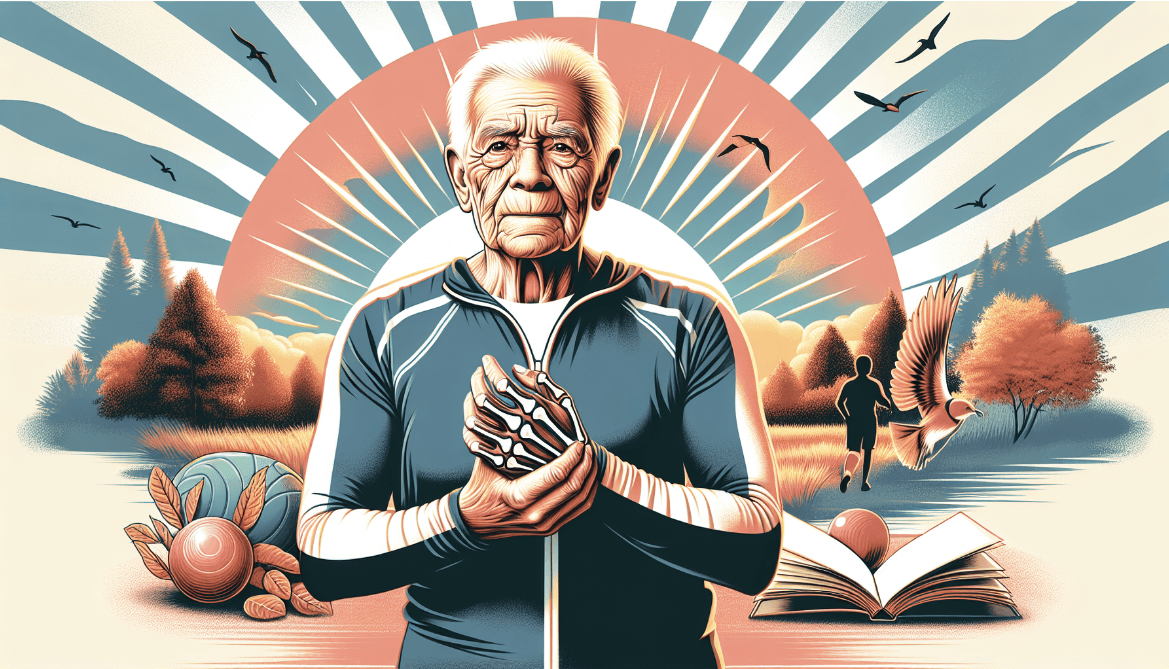Arthritis, a prevalent condition among the elderly, affects a significant portion of the population, with over 32.5 million adults in the US alone grappling with its challenges. It encompasses over 100 types, with osteoarthritis (OA) and rheumatoid arthritis (RA) leading as the most common forms, underscoring not only its widespread impact but also the diverse nature of the disease that demands targeted arthritis relief strategies.
This article aims to explore the intricacies of arthritis in the elderly, from identifying arthritis symptoms to navigating through various arthritis treatments. By delving into management and treatment options, including exercise, medications, therapy, and weight management, and highlighting preventive measures, it seeks to offer comprehensive insight into enhancing patient care and achieving pain relief.
Understanding Arthritis in the Elderly
Understanding the different types of arthritis that predominantly affect the elderly is crucial for both patients and caregivers to tailor appropriate management strategies. Here’s a breakdown of the most common forms:
- Osteoarthritis (OA): Often referred to as a degenerative joint disease, OA can impact any joint but predominantly affects the hands, knees, hips, lower back, and neck. This condition is characterized by the breakdown of cartilage, leading to pain, stiffness, and decreased mobility.
- Rheumatoid Arthritis (RA): RA is an autoimmune disorder where the body’s immune system mistakenly attacks the joints, causing inflammation and damage. This can result in pain, swelling, and sometimes deformity.
- Gout: Triggered by the buildup of uric acid crystals, gout frequently targets the big toe, causing intense pain and swelling.
- Psoriatic Arthritis: Associated with psoriasis, this condition leads to joint inflammation and can also cause scaly skin patches.
Comparative Analysis:
| Arthritis Type | Primary Areas Affected | Cause | Risk Factors |
|---|---|---|---|
| Osteoarthritis | Hands, knees, hips, back, neck | Wear-and-tear on joints | Age, obesity, joint injury, genetics |
| Rheumatoid Arthritis | Joints generally | Autoimmune disorder | Genetics, smoking, environmental factors |
| Gout | Big toe, joints | Uric acid crystal buildup | Diet, obesity, alcohol consumption |
| Psoriatic Arthritis | Joints, skin | Linked to psoriasis | Psoriasis, genetics |
While OA and RA are among the most prevalent, affecting millions globally, understanding that arthritis is not a singular condition but a category of over 100 types, each with unique causes and treatment pathways, is essential. For instance, OA is a result of joint wear-and-tear, whereas RA is an autoimmune response. This distinction is critical for effective treatment and management.
The impact of arthritis on the elderly is profound, not only in terms of joint health but also considering the broader implications on overall well-being. Women, for instance, are twice as likely to develop OA, which can lead to significant functional disability, loss of joint motion, and even social isolation due to pain and mobility limitations. Furthermore, OA is linked with higher comorbidity rates, including obesity, diabetes, and heart disease, underscoring the need for a holistic approach to patient care that goes beyond managing arthritis symptoms to addressing overall health and lifestyle factors.
Understanding arthritis in the elderly involves recognizing the multifaceted nature of the condition, the various types affecting this demographic, and the broader health implications. Such knowledge is pivotal in devising comprehensive care strategies that improve quality of life for the elderly battling arthritis.
Common Symptoms and Diagnosis
Arthritis in the elderly is marked by a range of symptoms that significantly impede daily functions and quality of life. The most commonly reported symptoms across various types of arthritis include:
- Joint Pain and Stiffness: A universal symptom that varies in intensity from mild to debilitating. Pain often worsens after periods of inactivity or overuse.
- Swelling: Affected joints may appear larger or more swollen due to inflammation.
- Reduced Range of Motion: Movement becomes restricted, making it difficult to perform everyday tasks.
- Grating Sensation: Especially noted in Osteoarthritis (OA), where the cartilage wears down, causing a sensation of bone rubbing against bone.
- General Symptoms: Fatigue, fever, and rash are associated with specific types of arthritis, like Rheumatoid Arthritis (RA).
Diagnosing arthritis involves a multi-faceted approach tailored to identify the type and severity of the condition:
- Medical History and Physical Examination: A comprehensive review of symptoms, family history, and a physical exam to check for swelling, redness, and flexibility of the joints.
- Laboratory Tests:
- Joint Aspiration: Extracting fluid from the swollen joint to look for uric acid crystals (indicative of Gout) or to rule out infection.
- Blood Tests: Identifying markers such as Rheumatoid Factor, C-reactive protein, and an elevated erythrocyte sedimentation rate can indicate RA.
- Imaging Scans:
- X-Ray: Reveals joint space narrowing, cartilage loss, and bone spurs, common in OA.
- MRI: Provides detailed images of soft tissues, including cartilage and tendons, to detect early signs of joint damage.
Symptom and Diagnosis Comparison Table:
| Symptom | Osteoarthritis (OA) | Rheumatoid Arthritis (RA) |
|---|---|---|
| Joint Pain and Stiffness | Gradual onset, worsens with use | Symmetrical, often severe in the morning |
| Swelling | Less common | Common, with warm, red joints |
| Range of Motion | Reduced, grating sensation | Reduced, with joint deformities |
| General Symptoms | Rare | Fatigue, fever, rash |
| Diagnostic Tests | X-ray, MRI | Blood tests, X-ray, MRI |
Consulting a healthcare provider upon experiencing joint pain, stiffness, or swelling is crucial for early diagnosis and treatment. Early intervention can significantly mitigate the progression of arthritis, enhancing the quality of life for the elderly.
Impact on Daily Life
Arthritis significantly impacts the daily lives of the elderly, affecting their ability to perform basic activities and maintain independence. Here are some practical adjustments and strategies to mitigate these challenges:
- Home Safety and Accessibility Modifications:
- Install anti-slip mats in areas prone to wetness, ensure all spaces are well-lit, secure loose carpets, and use guard rails in necessary spots to prevent falls.
- Replace heavy cooking ware with lighter alternatives and keep frequently used items within easy reach to minimize strain.
- Use labor-saving devices and adaptive aids like jar openers, button hooks, and extended grabbers to reduce the need for painful movements.
- Opt for non-slip flooring that offers cushioning or shock absorption to ease joint stress.
- Lifestyle Adjustments for Enhanced Well-being:
- Everyday chores such as cooking, laundry, and gardening can become increasingly difficult. Employing strategies like breaking tasks into smaller steps or using ergonomic tools can help manage these activities.
- Support from family and friends plays a crucial role. Open communication about the condition and its limitations can foster understanding and assistance.
- Work modifications may be necessary for those experiencing difficulty in their job due to arthritis. Discussing adjustments with employers, such as flexible scheduling or ergonomic workstations, can aid in maintaining employment and distraction from symptoms.
- Maintaining Social and Emotional Health:
- Arthritis can lead to social isolation and depression due to limitations in participating in religious, social, and recreational activities. Engaging in joint-friendly physical activities and community programs can help maintain social connections and improve mood.
- Concerns about appearance, motherhood, partnership, and sexual relationships are common. Seeking support from healthcare providers, counselors, or support groups can provide strategies for coping with these emotional challenges.
- For those who drive, specialized vehicle modifications and adaptive driving equipment can help maintain independence and mobility.
These adaptive strategies and modifications aim to not only alleviate the physical symptoms of arthritis but also address the emotional and social challenges, enhancing the overall quality of life for the elderly affected by this condition.
Management and Treatment Options
Effective management and treatment of arthritis in the elderly encompass a multi-faceted approach, integrating both pharmacologic and non-pharmacologic strategies. Here’s a breakdown of the options available:
Non-Pharmacologic Treatments:
- Exercise and Physical Activity: Regular low-impact aerobics, strength training, and flexibility exercises such as walking, biking, and swimming are pivotal. Exercise not only helps with weight management but also improves joint mobility and reduces pain.
- Weight Management: Maintaining a healthy weight reduces the stress on joints, especially in the hips and knees, thereby alleviating pain and preventing further damage.
- Therapy: Both physical and occupational therapies are instrumental in improving movement, strength, endurance, and function. They also offer strategies for joint protection and energy conservation to make daily tasks easier.
- Assistive Devices: Utilizing braces, canes, and other aids can improve joint stability, balance, and reduce the risk of falls.
- Mind-Body Treatments: Approaches such as acupuncture, massage, and heat and cold treatments can offer significant pain relief.
- Lifestyle Modifications: Simple changes, including ergonomic work environments and the use of long-handled tools, can protect joints and enhance quality of life.
Pharmacologic Treatments:
- Non-steroidal Anti-inflammatory Drugs (NSAIDs): These are commonly recommended for pain relief; however, their use, especially in the elderly, should be monitored due to potential side effects.
- Topical Medications: NSAIDs and capsaicin creams can provide targeted pain relief with minimal systemic effects.
- Intra-articular Injections: Corticosteroids and hyaluronic acid injections can reduce inflammation and provide lubrication in the joint, respectively.
- Acetaminophen: Often recommended as initial therapy due to its safety profile, it’s effective for pain management in many patients.
- Alternative Medicines: Supplements such as glucosamine, chondroitin, and fish oil, along with practices like yoga and tai chi, can support symptom management.
Surgical Options:
- Joint Replacement Surgery: In severe cases where conservative treatments have been exhausted, surgical options such as total or partial joint replacements may be considered to restore function and relieve pain.
It’s essential for patients and caregivers to work closely with healthcare providers, including rheumatologists and orthopedic surgeons, to tailor a treatment plan that addresses the specific needs and conditions of the elderly patient. This collaborative approach ensures not only the alleviation of symptoms but also an enhancement in the overall quality of life, enabling seniors to navigate the challenges of arthritis with greater ease and confidence.
Prevention and Healthy Living Tips
To foster arthritis relief and promote healthy living among the elderly, adopting a holistic approach towards lifestyle choices is essential. This encompasses dietary adjustments, weight management, and maintaining an active lifestyle, among other preventive measures. Below are detailed strategies aimed at minimizing the risk of arthritis and enhancing overall well-being:
Dietary Considerations
- Omega-3 Fatty Acids: Incorporate foods rich in Omega-3s, such as salmon, trout, mackerel, sardines, nuts, seeds, and plant oils. Fortified eggs or juices can also be beneficial. These nutrients are known for their anti-inflammatory properties, which can alleviate arthritis symptoms.
- Anti-inflammatory Foods: Emphasize a diet abundant in anti-inflammatory foods. This includes a variety of fruits, vegetables, whole grains, and lean proteins. Antioxidants found in these foods can help reduce inflammation.
- Supplements: Consider supplements like omega-3 fish oil, glucosamine, and SAMe, which may offer additional benefits in managing arthritis symptoms. However, always consult with a healthcare provider before starting any new supplement regimen.
Weight Management and Exercise
- Maintain a Moderate Weight: Excess weight places additional pressure on joints, particularly on the hips and knees. Achieving and maintaining a healthy weight through a balanced diet and regular exercise is crucial.
- Regular Physical Activity: Engage in low-impact exercises, including endurance, strength, flexibility, and balance exercises. Activities such as walking, biking, and swimming are excellent choices. Regular exercise not only aids in weight management but also improves joint mobility and reduces pain.
Lifestyle Modifications
- Quit Smoking: Smoking cessation is vital, as smoking can lower the effectiveness of arthritis treatment and increase the risk of developing arthritis.
- Infection Prevention: Promptly treating infections can help prevent infectious arthritis. Maintaining good hygiene and staying up-to-date with vaccinations are key preventive measures.
- Blood Sugar Control: Monitoring and controlling blood sugar levels are important to reduce the risk of diabetes-related arthritis. A healthy diet and regular physical activity can aid in managing blood sugar levels.
- Protect Your Joints: Minimize repetitive movements and avoid injuries to cartilage, ligaments, and joints. Using ergonomic tools and making home safety modifications can help protect joints from unnecessary stress.
Incorporating these strategies into daily life can significantly contribute to preventing arthritis and improving the quality of life for the elderly. It’s essential for individuals to consult with healthcare professionals to tailor a prevention plan that best suits their needs and conditions.
FAQs
What are the most effective arthritis treatments for older adults?
The most effective treatments for arthritis in older adults include non-pharmacological approaches such as regular exercise, weight management, engaging in physical therapy, using bracing, and employing assistive devices like canes and walkers. These strategies are preferred initially to reduce the potential negative effects that medications may have on the elderly.
Are there specific foods that can worsen arthritis symptoms?
Yes, certain foods can exacerbate arthritis symptoms and should be avoided. These include processed foods like baked goods and prepackaged meals, foods high in omega-6 fatty acids, sugary items and some sugar substitutes, red meat, fried foods, refined carbohydrates, cheese and high-fat dairy products, as well as alcohol.
What are the best beverages for individuals with arthritis?
The best drinks for those with arthritis include tea due to its numerous health benefits, milk (since dairy does not need to be eliminated from the diet of those with arthritis), coffee, fresh juices, smoothies, and red wine in moderation. It’s also essential to stay hydrated by drinking plenty of water. If you have concerns about your diet and arthritis, it’s advisable to consult with a doctor.
How can severe arthritis pain be managed?
For unbearable arthritis pain, applying ice or heat can provide relief. It’s also important to consult a doctor about the possibility of taking nonsteroidal anti-inflammatory drugs (NSAIDs). A specialist can recommend tailored exercises or physical therapy and provide assistive devices like canes. They may also prescribe oral and topical medications, as well as injections such as cortisone shots, to help manage the pain.












